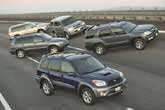Recent Articles
Popular Makes
Body Types
Avoiding Accidents
How Toyota's latest technology keeps you safe
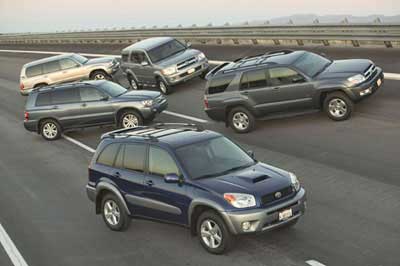
PHOENIX – Thick, wet, heavy snow falls at a rate of an inch per hour, coating the road ahead with a slick glaze of ice. In the windshield, now just two arcs swept clean by the wiper blades – -- two flickering orange lights appear. A motorist ahead is having trouble, stopped at the side of the highway, flashers activated. But as you approach, your headlights reveal that the motorist is stopped in your lane instead, directly ahead of your vehicle. Adrenalin floods your body, your foot stomps on the brake, and your arms flail at the wheel. Panic sets in as the car begins to slide on the icy pavement, the headlights now illuminating the woods along the side of the road as all four wheels glide laterally along the snow-coated double yellow line. …Wham! Impact. Had you been driving one of many new Lexus, Scion or Toyota models equipped with active and passive safety systems, there might not have been a Wham! in the first place. Just an adrenalin rush. Celebrated for building usually durable, sometimes hip, increasingly more environmentally responsible vehicles that reflect a passionate pursuit of perfection, Toyota Motor Corporation is also focusing its tremendous engineering and marketing resources on safety – and not just because the subject is a big selling point these days. These active and passive technologies, along with others being developed at an increasing rate, work together to potentially reduce injury and to possibly help you avoid the accident in the first place. Case in point: The company equips every new sport-utility vehicle it sells with what it calls a Star Safety Package. Since the 2004 model year, every Lexus and Toyota SUV is equipped with traction control, stability control, and antilock brakes with brake assist and electronic brake-force distribution. The Star Safety Package includes active safety features, which are different from passive safety features. Passive safety refers to items that work to reduce injury once an accident has occurred, such as seatbelts and airbags. Active safety refers to technology that is designed to help the driver avoid the accident in the first place. And Toyota has been working overtime creating new active safety systems. To allow reporters the opportunity to test some of its latest active safety developments in a controlled environment, Toyota invited the press to its proving grounds in the Sonoran desert near Phoenix to exercise technology that cannot be seen but can definitely be felt when driving conditions go from sublime to extreme.
VSC
Vehicle Stability Control (VSC), first used by Toyota in selected 1997 Lexus models, is neither a new nor an exclusive technology. But Toyota is proud of the fact that VSC is standard on every new Lexus, all of its SUVs, most of its Sienna minivans, and the Scion xB. VSC is available as an option on almost all other vehicles the company sells in North America. Working through a vehicle’s antilock braking system (ABS) and traction control system, VSC employs three sensors to detect and react to a lateral, or sideways, skid. By calculating data gathered by the lateral G-sensor, yaw-rate sensor, and steering angle sensor, VSC can tell when a vehicle’s direction of travel differs from the driver’s inputs at the wheel. Under those conditions, VSC activates both the traction system’s throttle control and the ABS to help correct a skid and keep the vehicle traveling on the driver’s intended path. VSC engagement is preceded by a beep inside the vehicle to warn the driver that the system has determined that a skid is about to occur. This year, the National Highway Traffic Safety Administration (NHTSA) concluded that uncontrolled lateral skids resulting from sudden steering input and changing road conditions cause a significant number of injuries and fatalities in single-car accidents. VSC, and other systems like it, helps to prevent these kinds of accidents.

VDIM
Toyota’s new Vehicle Dynamics Integrated Management (VDIM) system takes VSC one step further. Normally, VSC engagement is obvious to the driver, and not just because it beeps when a skid is about to occur. VSC can engage harshly, producing a vibration, a grinding noise, and sudden brake application. VDIM, available today in the Lexus GS 430, Lexus RX 400h, and Toyota Highlander Hybrid, is planned to roll out across the entire Lexus, Scion and Toyota lineups in coming years, and is designed to perform the same function as VSC, but in a smoother manner. VDIM relies on the same set of sensors as VSC, but also takes into consideration signals carrying data about deceleration rates, brake pressure, brake pedal application, and wheel speed. Key to VDIM’s performance, because they create the electronic data upon which the system is dependent, are drive-by-wire steering and braking systems, and, on the GS 430, an active steering system that varies the steering ratio depending on vehicle speed. To demonstrate the effectiveness of VDIM, Toyota provided us with Highlander SUVs on a dirt handling course and Lexus GS sedans on a wet, paved handling course. First we drove the Highlanders, lapping the course with VSC off, VSC on, and VDIM on. With VSC off, the Highlander was terrific fun, and we tossed it around like a rally car as we threaded the cones. But lots of people don’t think sliding a car around on a loose surface is terrific fun, especially when the sliding is unexpected, preferring instead the safety net of VSC. With VSC engaged, the Highlander reacted almost violently as we purposely dialed in too much steering, beeping and grinding and rocking and pitching in an effort to bring the SUV back under control. Plus, when we made an attempt to run the slalom smoothly and without VSC intervention, the system snapped to attention early – almost too soon. In contrast, the Highlander Hybrid, with its VDIM system, behaved in a subtle manner, scrubbing less speed and correcting skids in a smoother, almost elegant fashion. The difference was plainly clear during a demonstration in which a professional driver screamed around a lengthy, winding, gravel test road located on the proving grounds, doing his best interpretation of pro-Rally driver Colin McRae as he pitched the Highlander into curves doing twice the speed that most people would consider prudent. Not only did this exercise highlight the leap in technology that VDIM represents over VSC, but it also underlined just how competent any stability control system is in preventing a wreck. And, it proved that driving, or riding in, a Toyota Highlander can actually be fun. Sometimes. On the wet handling course, VDIM also proved its mettle. Lexus GS 300s with the standard VSC turned off regularly snacked upon cones, with at least one journalist performing a lurid 360-degree spin. With VSC on, the cone runners got to sit in their air-conditioned trucks, and we experienced the same sudden and intrusive butt-saving as we had in the Highlanders. The Lexus GS 430, with VDIM, allowed for smooth and rapid slaloming with barely a hint that the system was working to keep the GS pointed in the direction we wanted to go.
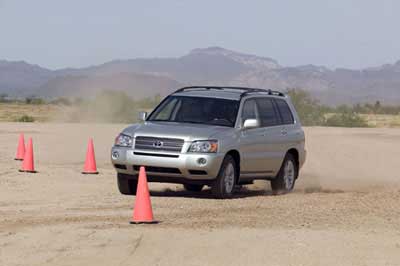
KDSS
Anyone who has driven a Lexus GX 470 to extremes has probably come away from the experience impressed with the SUV’s off-roading capability but disappointed in its on-road handling. The GX 470, as luxurious as it may be, is based on a true off-roader that in other parts of the world is labeled a Toyota. And true off-roaders are not usually any good to drive as daily commuters from the suburbs to the city. Although, given the state of this nation’s roadways, we’ll concede that daily commutes can sometimes be considered off-roading. But that’s another story. Equipped with an option called Kinetic Dynamic Suspension System (KDSS), the Lexus GX 470 is a far more civilized sport-ute than it is without KDSS. Since early 2004, KDSS has been available to combat the excessive body motion that plagues the GX 470, making it feel unstable and sluggish on paved roads and causing discomfort on backwoods trails. To reacquaint ourselves with the GX 470’s penchant for producing motion sickness, we drove one on a tough handling course littered with dirt moguls, trenches, and rocks. Without KDSS, the stock GX 470 produced significant head toss, lurched on its suspension, and divorced its tires from the difficult trail. On another section intended to simulate highway driving, the GX keeled over in turns and tossed its considerable weight around, making it unstable in certain conditions. KDSS resolves most of these negative handling traits. Simple cylinders filled with hydraulic fluid and located inside larger front and rear stabilizer bars allow KDSS to increase or reduce the bars’ roll stiffness as conditions require. On the highway, this translates to stiffer stabilizer bars that produce less body roll and equalize wheel loading for a more controlled feel from behind the wheel and better response at the tires’ contact patches. Off-road, KDSS reduces stabilizer bar stiffness to increase wheel travel, resulting in less body motion and head toss on tough terrain while keeping the rubber planted on terra firma. Included in the $1,800 Sport Package or available as a stand-alone option for $1,750, KDSS has been added to just 12 percent of the GX 470’s that have rolled off showroom floors in 2005. That’s an appalling figure, given how KDSS totally transforms the driving experience. C’mon, GX 470 buyers, what’s another coupla grand when you’re already spending 50 g’s? KDSS is definitely worth it for the more sure-footed highway response alone. And a more responsive vehicle is an inherently safer vehicle.
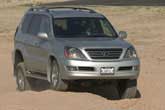
HAC/DAC
People who love exploring back woods trails that require the engagement of a low-range four-wheel-drive system probably know what it feels like to be stuck or stopped on a steep hillside, unsure how to ascend or descend safely and securely. Toyota’s Hill-start Assist Control (HAC) and Downhill Assist Control (DAC) aim to give drivers a safety net in these conditions. Offered on the Lexus GX 470 and Toyota 4Runner SUVs since 2003, HAC and DAC are also available on the redesigned 2005 Toyota Tacoma pickup. Using active wheel speed sensors and the braking system, HAC helps to prevent a vehicle from rolling backward or sliding sideways during the brief period when the driver releases the brake pedal and depresses the accelerator pedal. However, HAC is not a “hill-holder” mechanism – Toyota says it works for about three seconds, enough time to take your foot off the brake, place it onto the gas, and get the vehicle moving up the hillside. Only vehicles equipped with an automatic transmission can be equipped with HAC. Using a brand-new 4Runner, we tried the system out on a 20-percent grade with the four-wheel-drive system in 4Lo. We sat, and sat, and sat – for at least half a minute – without a foot on the brake or on the gas. The 4Runner didn’t budge. So we had to take Toyota’s word for HAC’s three-second timeout limit, because all we learned is that a 4Runner’s V6 produces enough torque to hold the truck still on a paved 20-percent grade when the transfer case is in 4Lo. DAC, on the other hand, is a handy piece of technology. Using a combination of engine braking and 4Lo gearing to hold a vehicle between two and four miles per hour for steep descents, DAC ensures steady, careful progress in dicey conditions. DAC will work with both manual and automatic transmissions, but requires 4WD and use of the transfer case’s 4Lo setting. Just don’t tap the brakes or the accelerator, because DAC demands your trust to work properly. If you get nervous and override the system with the pedals, you’re on your own.
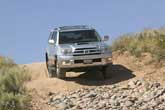
DLCC
Dynamic Laser Cruise Control (DLCC) is a relatively new technology that is mainly found on luxury vehicles, like the Lexus LS 430 and RX 330. But Toyota is making it available on the top-end versions of the Avalon sedan and Sienna minivan, the models used for our demonstration at the company’s Arizona proving grounds. Designed to automatically maintain pre-set distances between your car and vehicles ahead, DLCC is not a collision avoidance system, and Toyota emphasizes that it will not prevent accidents. You cannot rely on DLCC to stop the car if traffic up ahead suddenly grinds to a halt. Rather, DLCC maintains safe, pre-set distances between your vehicle and the cars in front of you in light to moderate traffic that is flowing reasonably well. It works by firing a laser beam from the front of your car. The laser beam reflects off the vehicles ahead and is captured by a receiver that transmits the data to a computer, which calculates the following distance. If the following distance is less than the pre-determined distance, your car will automatically slow down. And if someone cutting in front suddenly halves the distance, the system will activate the brake lights as your car slows so that motorists following you won’t introduce their cars to yours. Sounds complicated? You’re right, and it gets worse. Select from three different following distances, depending on conditions. And if you want more control over your driving, DLCC offers a conventional operation mode, but it’s not the default setting so you’ve got to use the cruise control switch to change modes. Shut the car off while refueling, and the system returns to the default DLCC setup. Furthermore, DLCC doesn’t work in the rain, disengaging after three swipes of the wiper blades. And in climates where it snows, precipitation can cover the laser emitter or the laser receiver, rendering DLCC inoperable. Ditto if mud gets on the front of the car. During our demonstration on the 10-mile oval track at the Toyota Arizona Proving Grounds, DLCC worked well. But keep in mind that this was a controlled experiment, we had a DLCC pro riding shotgun, and we still exited the Avalon Limited thinking the system was complicated to use. Since that exercise, we’ve had the extreme displeasure of using a similar system from a competing automaker out in the real world, which makes us think that Toyota squandered its engineering talent and budget on DLCC. Build a system that recognizes when some total idiot performs a braking test in the left lane of the freeway, dropping commute speeds from 60 mph to zero in the time it takes to yell “Holy Crap!” because somebody jumped out of the carpool lane to careen across five lanes of traffic for an exit, and then we can talk.
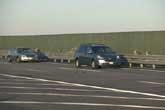
PCS
Toyota hopes that nobody will ever need its Pre-Collision System (PCS), because it only works when a crash cannot be avoided to scrub speed and position front seat occupants for best protection by the airbag systems. By analyzing data from the Dynamic Radar Cruise Control (DRCC, and different from DLCC though similar in operation), and combining it with information on vehicle speed, steering angle, and yaw rate, a computer decides if a crash is about to happen and immediately activates the pre-tensioning front seatbelts, drawing the belts tightly against the occupants and snugging them against the seatbacks. PCS also uses the Brake Assist feature to apply full braking power and reduce speed as much as possible before impact to minimize the amount of force that might reach the passenger compartment. On vehicles with Adaptive Variable Suspension (AVS), the PCS also reduces brake dive to make more efficient use of the Brake Assist system. Bet you’re curious how Lexus let us experience PCS first hand, eh? Engineers crafted a lightweight, deformable barrier that looked like it was covered in aluminum foil and which wouldn’t damage the car upon impact but would trick the safety feature into activating. It took several passes in a Lexus GS 430 to get PCS to work, but that was mainly because in this safe, controlled environment we weren’t easily able to replicate the panicked motions of a driver about to do serious sheetmetal damage. But when the system finally did perform its trick, it responded powerfully, instantaneously, and impressively. The seatbelts snap into action, cinching your body tight against the seat, while the Brake Assist system feels like it’s tossed an anchor out of the trunk. Once the GS shuddered to a stop, the shiny barrier rolling around in front of it like a fallen alien pedestrian, the seatbelts whirred, clicked, and released, freeing us to make another pass for more and . PCS requires the Dynamic Radar Cruise Control system and is available on the Lexus GS 300 and GS 430 for $2,850. On the Lexus LS 430, PCS is bundled with the $8,185 Custom Luxury package or the $13,570 Ultra Luxury package. That’s a pricey insurance policy, especially when Lexus currently has very little real-world data to support the theory that it can save lives.
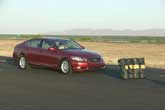
Wrap Up
Safety sells, and with today’s cars well equipped to handle a crash thanks to crumple zones, crash energy management, airbags, anti-whiplash systems, and other features that are either baked right into the package or added on as options, automakers like Toyota are turning their attention to finding ways to help avoid an accident in the first place. And it’s not just active safety equipment like that which we sampled in Arizona. Just weeks after our one-day visit to the desert, Toyota hosted its first teen driving course in Pasadena, Calif., using their employees, their children, and their children’s newly-minted driver’s licenses as test subjects to see if the concept could fly for the public on a national basis. Toyota knows that safety starts with an educated driver, and is committed to finding a way to better prepare people for the responsibility of driving an automobile. After all, the company is already spending millions on technology that could save your skin. Makes sense to make sure you know what to do with it.
Photos courtesy of Toyota Motor Sales, USA
